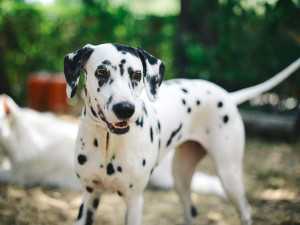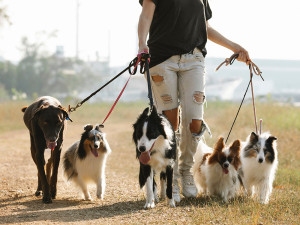Origins of the Dog Family Tree
Researchers map the evolution of dog breeds.

Share Article
Dogs come in a wide variety of shapes and sizes, from Mastiffs and Great Danes to Chihuahuas and teacup Poodles, and are all part of the same Canis lupus familiaris species. But how did so many different breeds come to be, and just how closely related are they? Geneticists Heidi Parker and Elaine Ostranderopens in a new tab, along with a team of colleagues from the National Human Genome Research Institute, set forth to figure that outopens in a new tab.
How the oldest dog breeds evolved.
The scientists’ interest was in the origin of the breeds, not the origins of canine domestication. Their aim was to build a family breed tree and to understand what makes some breeds more susceptible than others to certain diseases.

Get (totally free) deals for food, treats, accessories, tech, and way more pet parenting must-haves.
opens in a new tabThey worked from a sample size that included 1,346 dogs representing 161 breeds, or not quite half of all those known to exist. By comparing the differences at 150,000 spots on each dog’s genome, they built a family tree. This is still very much a work in progress, as there are at least 350 breeds of dogs.
Almost all the breeds fell into 23 groupings, called clades, and this amazing cladogram shows how the various breeds are related, not just genetically but also by common traits. For instance, hounds like Beagles, Afghans and Salukis are in one clade, and dogs bred for strength—Boxers, Bulldogs and even Boston Terriers for example—are in another.
Connections between common dog traits.
Besides sorting breeds into clades, the study also provided estimated dates that cross-breeding occurred, and distinguished breeds geographically. Even dogs bred for a specific purpose, like herding, can show considerable diversity based on geography and time periods. As Parker noted, “This shows herding is not a recent thing. People were using dogs as workers thousands of years ago.”
Different herding dogs use very different strategies to bring their flocks to heel, so in some ways, the phylogenetic data confirmed what many dog experts had previously suspected, the researchers noted. "What that also tells us is that herding dogs were developed not from a singular founder but in several different places and probably different times," says Ostrander. In contrast, Pointers and gun dogs and Spaniels share very tight genetic groupings and display little genetic variation, and their origins can be traced to Victorian England.
In another really interesting finding, the research points out how some breeds were used to create other breeds, and the extent to which DNA and the mutations it may carry can be shared across multiple clades. The Pug is great example; it was used to shrink the size of other breeds as early as the 1500s. As Parker noted, “Pug DNA is part of many other toy and small dog genomes.”
How this information helps dogs.
Understanding dogs' genetic backstory also has practical applications. Our canine compatriots fall victim to many of the same diseases that humans do--including epilepsy, diabetes, kidney disease, and cancer--but disease prevalence varies widely and predictably between breeds, while it is more difficult to compartmentalize at-risk human populations. "Using all this data, you can follow the migration of disease alleles and predict where they are likely to pop up next, and that's just so empowering for our field because a dog is such a great model for many human diseases," says Ostrander. "Every time there's a disease gene found in dogs, it turns out to be important in people, too."
This information is important to mixed-breed dogs because knowing the breeds involved, and the clades those breeds belong to, can help in finding potential genetic health problems. One of the best examples is in diagnosing a disease such as collie eye anomaly (CEA). While CEA can appear in collie-type dogs (in the herding clade), it can also occur in Nova Scotia Duck Tolling Retrievers. This analysis shows that this Canadian sporting breed dog has either Collie or Shetland Shepherd ancestors who may have passed on the defective gene.
As Robert Wayne, an evolutionary biologist at the University of California, Los Angeles, not involved with the study, observed, “Mixing has resulted in the sharing of specific genomic regions harboring mutations which cause disease in very different breeds.”

Claudia Kawczynska
Claudia Kawczynska was co-founder and editor-in-chief of The Bark for 20 years. She also edited the best-selling anthology Dog Is My Co-Pilot.
Related articles
![A cute Dalmatian standing outside among green bushes.]() opens in a new tab
opens in a new tabDNA Test Helps Dalmatians
Researchers identify the gene that causes bladder stones, thanks to a few Dalmatians.
![Back view of Saint Bernard puppy tail]() opens in a new tab
opens in a new tabHow to Tell if Your Dog is a Lefty or a Righty
Your dog’s wag and paw preference say a lot about their personality.
![A woman walking 5 dogs on leashes outside.]() opens in a new tab
opens in a new tabBreed Does Not Equal Behavior—Here’s Why
A new study found that a dog’s breed accounts for less than 10 percent of their behavior.
![]() opens in a new tab
opens in a new tabCancer is More Common in Purebred Dogs, Study Says
Nationwide’s veterinary analytics team looked at the cancer claims of 1.61 million dogs and found that purebred dogs are nearly twice as likely to get cancer as mixed breeds.




